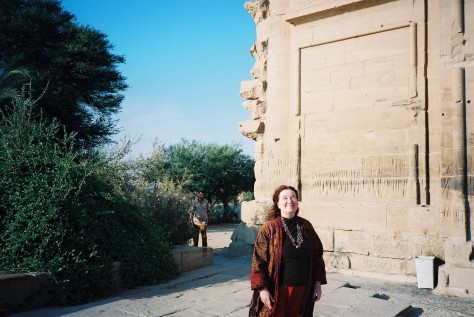Part Three
That evening, as they share their meal, she looks carefully at her Sister companions, listens to the stories they tell of nieces and nephews, of work projects. She no longer expects them to understand her project, her summer journey, but she is comforted by the talk they share.
This is the pattern for the three months of her exile. The book opens at her touch, draws her inside where the story continues. She learns that for the Ancient Egyptians, life exists at once on several planes, and time is both clock time and lasting time. In the durative realm, she may visit events that occur in other times.

One day, wandering like Isis, she comes in her Ka spirit to the place where shepherd children met the Virgin Mary in 1917, in Fatima, Portugal. She stands and watches as the story, familiar to her since her childhood, unfolds. She sees the light on the children’s faces, sees the solemn kindly being who greets them. She waits until the being looks finally at her. Then she asks what she must ask this Holy One: “Who are you?”
The radiant being smiles and says, “You know who I am.”
Isis brings Osiris to life
and conceives of him their child Horus.
But Seth captures Osiris
and hacks his body into fourteen pieces.
These he hurls into the Nile.
Isis and Nephthys together,
helped by the creatures of the river,
regather the scattered pieces of Osiris.
He goes to rest in the underworld, where he reigns as King.
The woman sees that the scattered pieces of her life are being sought out and rejoined in this mysterious adventure. She gives her trust to the journey, to its guide. For a long while now she has been aware that this guide is not the book’s author. She names her Isis, and strange though the name feels upon her lips, she is at home with this guiding presence who has known her, it seems, forever. Isis gives the woman new names for her body (companion), her mind (weaver), her emotions (seeker) and her spirit (Christa).
In a dream, Osiris instructs his son,
now grown to manhood, to defeat Seth.
A terrible battle rages for eighty years.
Horus wins, but Isis insists
that he not destroy Seth.
Horus is enraged and pulls
his mother’s crown from her head.
After a time, Horus gains wisdom.
He turns his heart to his mother
and recrowns her Queen of Earth and Heaven.
The room holds the darkness gently, and the darkness holds the woman. The days of her exile have almost ended, and she has come to the room where many years earlier she had sat as a young novice. The room is now a place of silent prayer and it watches her as she stands alone, holding in her outstretched hands a crown of mithril silver laced with emerald.
In her Ka, her spirit, she recrowns Isis.
She waits, knowing a gift will be offered in return. But at once she is overcome by shame. All her life she has been seeker, all her life she has been asking.
“Don’t give,” she says to the Holy presence. “Take something instead.” She doesn’t know where these words, this desire, have come from. “Take away this great emptiness that has made me a beggar of love for all my life.”
Even as she asks, she is afraid, for without this need, this longing, what would draw her to the Holy?
The fear dissolves in what is happening. She is being regifted in her birth. She is gushing forth, being presented to her mother, her mother who had been so afraid. But now another is there, pouring her love into child and mother both. And the woman thinks, “She is there in my birth blood. I am born into love and must ever now have more love than I can bear. I must give it as a mother with full aching breasts.”
The room yawns, believing nothing has happened.
A few days later, the woman, living once more in ordinary time, is visiting the city when a street woman approaches, begging. Grudgingly, she opens her purse, takes out a bill. Then for the first time she looks into the eyes of the other woman.
With no clear knowledge of what she will do or say, she embraces the street woman, holds her close and says, “Your life is so beautiful. Please, please take care of yourself.”
The street woman hugs her back. Both are startled. Then the woman who spent the summer lost in a book feels an astonished delight. Something wonderful has been born.
I have given you over recent weeks this three-part story, first written under the title, “Portal to Egypt”. The very day I completed the final edit, I received a phone call. Beyond hope, beyond even my dreams, I learned that a place had opened on the waiting list, that I would now be travelling to Egypt. In fact, almost immediately.
Nine days later I emerged from the Cairo Airport with the companions who would, with me, and guided by Jean Houston, spend eighteen days in the heart of Egypt. On our visits to tombs, pyramids and sacred sites we were often the only group present, allowing Jean to teach us, guide us, lead us in a stunning experience of the myths, the spirituality, the rituals of ancient Egypt.
You may read of the whole journey in my book Called to Egypt on the Back of the Wind (Borealis Press, Ottawa, Canada, 2014) http://borealispress.com Anne Kathleen McLaughlin



